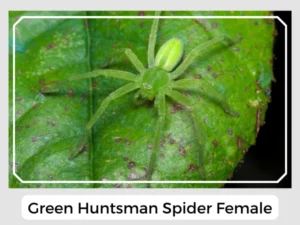The green huntsman spider is a special spider from the Sparassidae family. It’s found mostly in Northern and Central Europe. They are called “green huntsman” because of their bright green color. In this post, we will share some interesting facts about this unique spider.
The cephalothoraxes of the juvenile spider are yellowish-brown with dark median and marginal stripes.
The eggs are enclosed in a green clutch lying amidst leaves which are stitched together. Within a span of four weeks, they finally hatch.
Similar to all huntsman spiders, these species do not weave webs but hunt for their prey amidst the green vegetation and their camouflage is their biggest weapon in this regard.
Yes, Green Huntsman Spiders have venom. They use it to catch their meals. But for humans, the venom is typically mild.
They can bite if they’re bothered or scared. The bite might feel like a pinch and can cause swelling and redness.
The green huntsman spider plays a significant role in controlling insect populations in its habitat. Their dietary preference for small insects and other invertebrates helps maintain a balanced ecosystem. The vibrant green coloration serves a dual purpose: It offers an impeccable camouflage amidst the greenery, helping them blend seamlessly while hunting prey and evading predators.
Natural Predators: Life isn’t easy for the green huntsman spider. Predators such as geckoes, birds, wasps, flies, and nematode worms are ever-vigilant, turning the tables on our stealthy hunter. The spider’s vibrant coloration, while aiding in hunting, is also its shield against these predators, allowing it to blend with its surroundings.
Prey-Predator Dynamics: Being agile hunters, green huntsman spiders play a pivotal role in controlling the population of small insects and invertebrates, their primary diet. However, they must constantly evade their predators, resulting in a delicate balance within the food chain, ensuring that no one species dominates.
Relationship with Humans: While the green huntsman spider is venomous, it generally poses no significant threat to humans. Their venom is primarily used to immobilize their prey, making hunting more efficient. Though they can bite when threatened or provoked, their bite, for most, equates to a mild pinch, which might result in some swelling or redness.
| Distribution | Northern and Central regions of Europe including southern Britain and Denmark |
| Habitat | Forest edges, forest edges, dry woodlands |
| Diet | Small insects as well as other invertebrates |
| Predators | Geckoes, birds, wasps, flies, nematode worms |
| Lifespan | About 2 years |

In conclusion, the green huntsman spider stands as a testament to nature’s ingenuity. Its unique hunting techniques, crucial ecological role, and relatively mild disposition toward humans make it a fascinating subject for nature enthusiasts.
The green huntsman spider is a special spider from the Sparassidae family. It’s found mostly in Northern and Central Europe. They are called “green huntsman” because of their bright green color. In this post, we will share some interesting facts about this unique spider.
The cephalothoraxes of the juvenile spider are yellowish-brown with dark median and marginal stripes.
The eggs are enclosed in a green clutch lying amidst leaves which are stitched together. Within a span of four weeks, they finally hatch.
Similar to all huntsman spiders, these species do not weave webs but hunt for their prey amidst the green vegetation and their camouflage is their biggest weapon in this regard.
Yes, Green Huntsman Spiders have venom. They use it to catch their meals. But for humans, the venom is typically mild.
They can bite if they’re bothered or scared. The bite might feel like a pinch and can cause swelling and redness.
The green huntsman spider plays a significant role in controlling insect populations in its habitat. Their dietary preference for small insects and other invertebrates helps maintain a balanced ecosystem. The vibrant green coloration serves a dual purpose: It offers an impeccable camouflage amidst the greenery, helping them blend seamlessly while hunting prey and evading predators.
Natural Predators: Life isn’t easy for the green huntsman spider. Predators such as geckoes, birds, wasps, flies, and nematode worms are ever-vigilant, turning the tables on our stealthy hunter. The spider’s vibrant coloration, while aiding in hunting, is also its shield against these predators, allowing it to blend with its surroundings.
Prey-Predator Dynamics: Being agile hunters, green huntsman spiders play a pivotal role in controlling the population of small insects and invertebrates, their primary diet. However, they must constantly evade their predators, resulting in a delicate balance within the food chain, ensuring that no one species dominates.
Relationship with Humans: While the green huntsman spider is venomous, it generally poses no significant threat to humans. Their venom is primarily used to immobilize their prey, making hunting more efficient. Though they can bite when threatened or provoked, their bite, for most, equates to a mild pinch, which might result in some swelling or redness.
| Distribution | Northern and Central regions of Europe including southern Britain and Denmark |
| Habitat | Forest edges, forest edges, dry woodlands |
| Diet | Small insects as well as other invertebrates |
| Predators | Geckoes, birds, wasps, flies, nematode worms |
| Lifespan | About 2 years |

In conclusion, the green huntsman spider stands as a testament to nature’s ingenuity. Its unique hunting techniques, crucial ecological role, and relatively mild disposition toward humans make it a fascinating subject for nature enthusiasts.